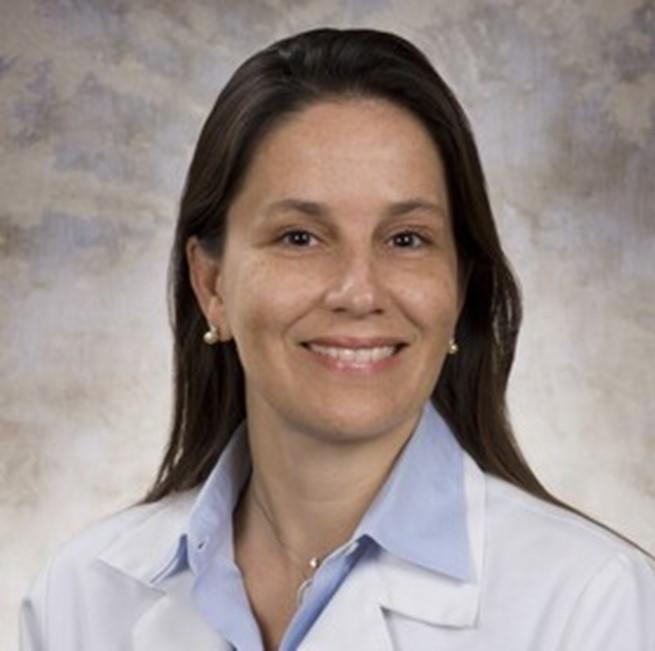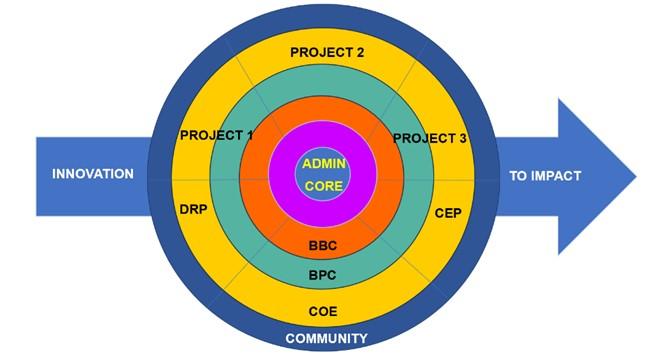University of Miami
Principal Investigators
Isabella Rosa-Cunha MD
Associate Professor of Clinical Medicine
University of Miami CRB – Clinical Research Building
1120 NW 14th Street, Room 847 (D-90A)
Miami, Florida 33136
(305) 243-4598
Erin Kobetz PhD, MPH
Professor of Medicine and Public Health Sciences
University of Miami
CRB – Clinical Research Building, 1120 NW 14th Street
Miami, Florida 33136
(305) 243-6185
Lisa Flowers M.D. MPH, FACOG
Professor of Gynecology and Obstetrics
Emory University
Woodruff Extension Building G033, 46 Armstrong St SE
Atlanta, Georgia 30303
(404) 251-8931
James Lillard PhD, MBA
Professor of Microbiology, Biochemistry &
Immunology
Morehouse School of Medicine
Hugh Gloster Building, Room 340
Atlanta, Georgia 30310
(404) 752-1863
Overview
The PeRsonalized Outreach and Multifaceted Interventions for Screening Enhancement (PROMISE) for Anal (AC) and Cervical Cancer (CC) Prevention and Treatment SPORE will address differences in cancer incidence and outcomes across different populations. Our program is comprised of a highly integrated group with an established history of collaboration. University of Miami Sylvester, Emory Winship, and Morehouse School of Medicine, individually and collectively, have been at the forefront of high-impact, translational science in AC and CC through validating screening modalities that circumvent multilevel impediments to disease prevention and early detection, as well as examining critical heterogeneity in disease etiology, onset, and progression. PROMISE will expand upon this work via three innovative, high-impact Research Projects, as well as pilot studies that seek to understand and/or address observed variability in disease outcomes across the cancer control continuum through our Developmental Research Program (DRP). Our commitment to community-engaged, translational science will inform the proposed activities of our Career Enhancement Program (CEP). All Projects and Programs will leverage the shared expertise of three Cores: The Community Outreach and Engagement Core (COE), Biospecimen and Pathology Core, and Biostatistics and Bioinformatics Core. PROMISE partners are committed to translating lessons learned from our work in AC and CC into a framework that informs addressing cancer differences across populations, more broadly, and deepening the longstanding connections between our academic and community partners to meaningfully modify the landscape of anal and cervical cancer prevention, early detection, diagnosis, and treatment.
Project 1: Al-driven patho-genomic predictive models for personalized treatment of cervical and anal cancers
The Project will address population differences in cervical cancer (CC) and anal cancer (AC). Our novel approach involves the development and validation of population specific and tailored prognostic and treatment response prediction models across large, unique, multi-institutional and clinical trial datasets. By integrating explainable artificial intelligence (XAI) and computer vision tools, we aim to:
Aim 1: Deep computational analysis of the Tumor Microenvironment (TME) to identify morphologic differences among American patients with African, European, and Hispanic ancestry (AA, EA, HA respectively) in CC and AC. Computer Vision and AI approaches will be employed to interrogate routine digital pathology (biopsy or resection) images from CC and AC patients to examine variations in collagen structure and immune architecture. This analysis will provide foundational data on how the TME contributes to differences in cancer outcomes among these ancestral groups.
Aim 2: Develop and validate ancestry-specific computational pathology based prognostic models for risk stratification in CC and AC. We will employ computer vision and AI based approaches to develop and validate prognostic models tailored to patients with African, European, and Hispanic ancestry to predict outcomes such as overall survival and disease recurrence. By comparing population-specific and population-diagnostic models, we will seek to improve risk stratification for CC and AC within the AA, HA and EA populations.
Aim 3: Develop and validate population-specific predictive models for treatment response in CC and AC across AA, EA, HA patients. We will focus on developing computational pathology-driven predictors of treatment response to chemotherapy, immunotherapy, and radiotherapy in AC and CC patients with African, European, and Hispanic ancestry. We will leverage both institutional datasets as well as data from completed clinical trials for AC and CC, to determine how population differences influence treatment response.
Impact: This effort will generate robust, interpretable, prognostic and predictive models that facilitate personalized treatment strategies, providing AI-driven solutions that are transparent and clinically translatable to different population groups.
Project 2: USCREEN- Anal self-sampling for human papillomavirus (HPV)
Anal cancer (AC), although rare among the general population, disproportionately affects several specific populations within the catchment areas of the University of Miami Sylvester Comprehensive Cancer Center and the Emory University Winship Comprehensive Cancer Center. AC is caused by human papillomavirus (HPV) and is preceded by anal high-grade squamous intraepithelial lesions (aHSIL), which are screening-detectable precancerous lesions that can be identified and treated reducing the risk of invasive AC. The prevention strategy relies on the routine use of high-resolution anoscopy (HRA) which has limited availability, even in resource-rich settings like the US.
The proposed study aims to fill this gap exploring novel screening methods to identify who can benefit most from HRA to better guide clinical triage and public health interventions are:
Aim 1: Determine whether self-sampling for anal hr-HPV is an acceptable screening modality for AC prevention among individuals at risk.
Aim 2: Determine the concordance between self-collected (SC) versus provider-collected (PC) samples for anal hr-HPV detection among individuals at risk. Hypothesis.
Aim 3: Examine the distribution of hr-HPV genotypes among individuals at risk, correlating with ancestry (self-reported vs. genomic ancestry testing), nativity, and social determinants of health (SDoH).
Exploratory Aim: After demonstrating acceptability and concordance of SC and PC samples, determine the feasibility of a community-based anal hr-HPV self-sampling program, as is necessary to inform future public health intervention.
Impact: The Project may lead to new strategies to facilitate anal cancer screening among individuals at risk, informed by individual differences (e.g., biological, environmental, SDoH related), bringing to the community a more personalized and effective anal cancer prevention program.
Project 3: Dynamics of Immune Signatures and Microbiome in Patients with Cervical Pre-Cancer and Cancer Among Women.
Cervical cancer (CC) remains a significant cause of cancer and death among women worldwide. Black and Hispanic women continue to have a disproportionate burden of disease and worse outcomes. Persistent infection with various strains of human papillomavirus (HPV) is responsible for most CC cases. Unfortunately, limited biomarkers exist to detect cervical dysplasia prior to progressing to cancer.
Emerging evidence has shown that the microbiome contributes remarkably to human health, and it has been linked to immune function, inflammation, and cancer. HPV infection and related cancers may be uniquely affected by the microbiome since these cancers arise in the cervical mucosa, which has a distinctive and rich microbial environment.
Due to persistent differences in CC prevalence among Black and Hispanic women, it is vital to investigate the mechanisms underlying these differences by dissecting the study of circulating immune cells, inflammatory responses, and their association with the microbiome and metabolome in the tumor tissue microenvironment (TME).
Aim 1: Investigate the differences of systemic and cervical immune profiles among different cervical tissue microenvironments (normal, cervical dysplasia, and cancer). Tumor-infiltrating immune cells are highly relevant to cancer development and represent promising biomarkers.
Aim 2: Evaluate the differences of microbiome and metabolome among different cervical tissue microenvironments (normal, cervical dysplasia, and cancer). CC is associated with alterations in microbial populations, and perturbations of the microbiome alters the metabolome.
Aim 3: Identify the population differences of the associations among the microbiome, metabolome, immune response, and inflammatory milieu in the cervical tissue microenvironments. There remains an unmet need to better understand the potential biological associations of different population characteristics and CC pathogenesis.
Impact: Our Project may help identify associations between the cervical microbiome, metabolome, immune mediators, and inflammation among different population groups, leading to the identification of unique host immune and microbial signatures associated with cervical carcinogenesis and the development of precision medicine and prevention.
Administrative Core (Admin Core)
The mission of the Admin Core of the PROMISE SPORE is to provide the organizational leadership needed for the SPORE to achieve its goals of career and research development, partnership building, and capacity building. As a unit, the Admin Core is comprised of an Executive Committee (executive decision leadership) and a Steering Committee (multiple Principal Investigators and Core Leadership). The Admin Core also manages the partnership with the Internal, External and Community Advisory Boards. The Admin Core provides strategic leadership and administrative oversight to advance SPORE goals and ensure that the PROMISE SPORE remains cohesive and aligned with study timelines. This Core provides all necessary services to support an efficient administrative system and infrastructure under the leadership of MPIs.
Biospecimen & Pathology Core
The Biospecimen and Pathology Core (BPC) of the PROMISE SPORE will establish a biospecimen repository of anal cancer (AC) and cervical cancer (CC) from different population groups that have unique incidence and mortality rates. Through well-established, multi-institutional collaborations among our participating institutions, the BPC will acquire different types of biospecimens to support all PROMISE Projects and anticipated needs of innovative pilot studies proposed as part of the Career Enhancement Program (CEP), the Developmental Research Program (DRP), and outside collaborations. The BPC will enable translational researchers to conduct high impact investigations that will change cancer treatment and outcomes.
Community Outreach & Engagement Core
Our SPORE institutions have significant experience working collaboratively with communities to advance mutually beneficial translational science. The PROMISE SPORE Community Outreach and Engagement Core (COE) is committed to ensure that our emerging science, its ultimate dissemination, and the career development of our trainees reflect the priorities and perspectives of community members and other stakeholders. By centering PROMISE around the voices and experiences of those directly impacted by cervical and anal cancers, we can make measurable progress toward advancing science in cancer and other health conditions that disproportionally affect the most vulnerable in the US.
Developmental Research Program
The Developmental Research Program (DRP) of the PROMISE SPORE aims to foster groundbreaking innovations to reduce illness and death from cancers that significantly affect vulnerable populations, and to create a pipeline of translational investigators committed to reducing cancer in these populations.
Career Enhancement Program
The Career Enhancement Program (CEP) of the PROMISE SPORE will prepare the next generation of basic science and clinical investigators to conduct robust, innovative, and impact-driven research in cancer, with special focus on cervical and anal cancers in populations that disproportionately bear the burden of these diseases, in alignment with the PROMISE SPORE mission.





